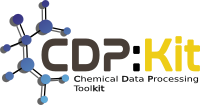 |
Chemical Data Processing Library Python API - Version 1.0.0
|
 |
Chemical Data Processing Library Python API - Version 1.0.0
|
SubstructureHistogramCalculator. More...
 Inheritance diagram for CDPL.Chem.SubstructureHistogramCalculator:
Inheritance diagram for CDPL.Chem.SubstructureHistogramCalculator:Classes | |
| class | Pattern |
Public Member Functions | |
| None | __init__ () |
| Initializes the SubstructureHistogramCalculator instance. | |
| None | __init__ (SubstructureHistogramCalculator calc) |
| Initializes a copy of the SubstructureHistogramCalculator instance calc. More... | |
| int | getObjectID () |
| Returns the numeric identifier (ID) of the wrapped C++ class instance. More... | |
| None | addPattern (MolecularGraph structure, int id=0, int priority=0, bool all_matches=True, bool unique_matches=True) |
| None | addPattern (Pattern ptn) |
| Pattern | getPattern (int idx) |
| None | removePattern (int idx) |
| None | clear () |
| int | getNumPatterns () |
| None | calculate (MolecularGraph molgraph, object histo) |
| SubstructureHistogramCalculator | assign (SubstructureHistogramCalculator calc) |
| Replaces the current state of self with a copy of the state of the SubstructureHistogramCalculator instance calc. More... | |
Properties | |
| objectID = property(getObjectID) | |
| numPatterns = property(getNumPatterns) | |
| None CDPL.Chem.SubstructureHistogramCalculator.__init__ | ( | SubstructureHistogramCalculator | calc | ) |
Initializes a copy of the SubstructureHistogramCalculator instance calc.
| calc | The SubstructureHistogramCalculator instance to copy. |
| int CDPL.Chem.SubstructureHistogramCalculator.getObjectID | ( | ) |
Returns the numeric identifier (ID) of the wrapped C++ class instance.
Different Python SubstructureHistogramCalculator instances may reference the same underlying C++ class instance. The commonly used Python expression a is not b thus cannot tell reliably whether the two SubstructureHistogramCalculator instances a and b reference different C++ objects. The numeric identifier returned by this method allows to correctly implement such an identity test via the simple expression a.getObjectID() != b.getObjectID().
| None CDPL.Chem.SubstructureHistogramCalculator.addPattern | ( | MolecularGraph | structure, |
| int | id = 0, |
||
| int | priority = 0, |
||
| bool | all_matches = True, |
||
| bool | unique_matches = True |
||
| ) |
| structure | |
| id | |
| priority | |
| all_matches | |
| unique_matches |
| None CDPL.Chem.SubstructureHistogramCalculator.addPattern | ( | Pattern | ptn | ) |
| ptn |
| Pattern CDPL.Chem.SubstructureHistogramCalculator.getPattern | ( | int | idx | ) |
| idx |
| None CDPL.Chem.SubstructureHistogramCalculator.removePattern | ( | int | idx | ) |
| idx |
| int CDPL.Chem.SubstructureHistogramCalculator.getNumPatterns | ( | ) |
| None CDPL.Chem.SubstructureHistogramCalculator.calculate | ( | MolecularGraph | molgraph, |
| object | histo | ||
| ) |
| molgraph | |
| histo |
| SubstructureHistogramCalculator CDPL.Chem.SubstructureHistogramCalculator.assign | ( | SubstructureHistogramCalculator | calc | ) |
Replaces the current state of self with a copy of the state of the SubstructureHistogramCalculator instance calc.
| calc | The SubstructureHistogramCalculator instance to copy. |